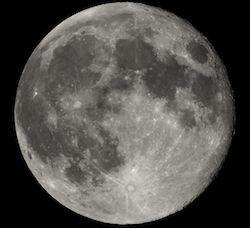
Studying Volcanoes from Far Away
 When you’re looking at the Moon at night, you can see different shapes and colors on the surface. Even though you’re far away, or remote, you’re able to learn a lot about the surface of the moon. Although we have rocks from the Moon, most of our observations occur from far away, or remotely.
When you’re looking at the Moon at night, you can see different shapes and colors on the surface. Even though you’re far away, or remote, you’re able to learn a lot about the surface of the moon. Although we have rocks from the Moon, most of our observations occur from far away, or remotely.
A lot of what we know about volcanoes on other planets and moons comes from satellites that we’ve launched into space. Occasionally, we can also learn a bit about them by using telescopes on Earth. Satellites can either orbit, fly-by, or land on other planets and moons. They can take pictures and make measurements using cameras and other tools.
One of the main ways we study the surfaces of other planets and moons is by taking pictures in visible light (the light we see with our eyes). We use satellites to take pictures of Earth, like we see in Google Earth. We also have Google Earth-like images for Mercury, the Moon, and Mars. On Venus, due to its thick, cloudy atmosphere, we can’t take visible images. Instead we rely on radar – a form of light invisible to humans. Radar images – made by radar light that bounces off the surface and returns to the spacecraft – can help us measure landforms and roughness. Radar shows us that some of the lava flows on Venus are smoother (like Hawaiian pahoehoe) and some are rougher (like Hawaiian a’a).
 But we can’t learn everything from pictures. For example, Google Earth provides detailed pictures of cities, but it doesn’t tell us what is inside each building or house. The ingredients, or composition, of lava can differ from volcano to volcano and from planet to planet.
But we can’t learn everything from pictures. For example, Google Earth provides detailed pictures of cities, but it doesn’t tell us what is inside each building or house. The ingredients, or composition, of lava can differ from volcano to volcano and from planet to planet.
Instead of regular cameras, we use spectrometers, which measure the light given off by objects. For example, minerals inside of the rocks that make up a lava flow give off light that we can’t see. Some of this light is in the infrared, which we can’t see with our eyes but we can feel with our skin as heat. The amount of light we measure tells us about the composition of the surface. From these observations we know that the lava on Mercury, the Moon, and Venus is similar to the lava on Earth.
Additional images via Wikimedia Commons. Curiosity spectrometer image by NASA/JPL-Caltech/MSSS.

Most of the instruments we send to space have special spectrometers to measure various light levels. Here, the metal rectangle in the middle of the image, with a circle in the middle, is an x-ray spectrometer on the Mars Curiosity rover.
Be Part of
Ask An Earth and
Space Scientist
By volunteering, or simply sending us feedback on the site. Scientists, teachers, writers, illustrators, and translators are all important to the program. If you are interested in helping with the website we have a volunteers page to get the process started.
